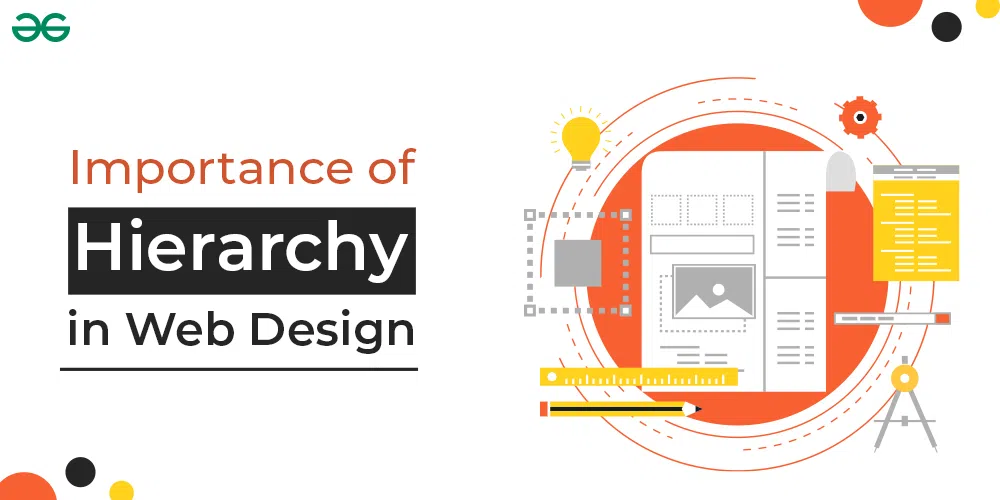Importance of Hierarchy in Web Design
Last Updated :
02 Nov, 2023
The arrangement of graphic elements in a design according to their significance is known as visual hierarchy. This methodology arranges design elements based on their importance, creating a user experience (UX) that highlights the main points—be it buttons, images, or text that you want users to interact with. The hierarchy is responsible for guiding the user’s attention to the specific features that the designer planned. Using a visual hierarchy enhances the visual appeal of content and simplifies the reader’s processing of data.

Importance of Hierarchy in Web Design
Why is Hierarchy Important in Design?
Along with space, contrast, and size, hierarchy is one of the four foundations of visual design principles.
Including visual hierarchy in the design of the website also helps in:
- Attracting Interest: Hierarchy focuses attention on improving user engagement. In order to draw the viewer’s attention to the composition as a whole and direct them through its elements using different levels of significance and logical flow, good design purposefully employs visual hierarchy.
- Directs the user’s journey: Visitors can more easily go through the content with the help of visual hierarchy, helping them to take in information to make wise choices and finish desired tasks.
- Shaping a layout that can be scanned: Important components and information stand out to convince users to engage with the website more.
Hierarchy also establishes the significance and arrangement of the element inside a composition. It impacts how viewers will view the content in order of occurrence. Readability, effect, and value can all be strongly impacted by sequencing.
Golden principles of hierarchy
Reading patterns: Z pattern and F pattern are the two major reading layouts.
- Z pattern: When viewing a page, users begin at the top left and proceed across to the top right, then descend and loop back to the bottom left and proceed through to the bottom right. Every corner features a call to action (CTA) or visual indication (such a logo or contact button).
- F pattern: Similar to Z pattern viewers, viewers start at the top left and proceed to the top right, but they scan faster and more quickly to the right by using the left half of the page as a guide. It performs well on pages with a lot of text.
Size and scale: As larger elements are considered as more significant and get more attention, size plays a crucial role in visual hierarchy. In a hierarchy, size and scale are used to convey information in order of priority. Bigger is visually striking, but it’s not always preferable, think about what you want users to see first when designing your webpage, and use that to guide your strategy.
Colour & Contrast: Color is an excellent tool in design to highlight specific elements. If color and contrast are used strategically, visitors get drawn to the elements you want them to notice first. If the background is muted, a high-contrast CTA button will stand out and vice versa. Try to make good use of color scheme to make information stand out and hold to the brand.
Typography: While designing, an another important insight to the type of message the design aims to convey is the type of font that is used. Fonts give a website an important visual component that helps text organization and categorisation.
There are three components to a font hierarchy:
- Primary: The primary text takes up the greatest space on the page, grabs the reader’s attention right away, and has the most important keywords.
- Secondary: Secondary fonts are basically the subheadings or secondary sub description. Though it doesn’t draw attention to itself as much as the main text, it still adds value and directs readers’ eyes throughout your website.
- Tertiary: Tertiary texts are the smallest character on the page but they are still readable. They are mostly used in captions.
Rule of thirds: A grid pattern that divides a rectangle into thirds both horizontally and vertically is the foundation of the rule of thirds. The rule of thirds has long been used by graphic designers, photographers, and artists to enhance compositional balance. The guideline promotes efficient alignment, creative element connection, and the use of negative space.
Proximity: One of the fundamental concepts of graphic design is proximity. According to the visual hierarchy, similar objects should be located closer to one another and Elements with no connection to one another should be arranged farther apart in the design composition.
Repetition: One may create something more significant and noticeable by repeatedly using the same pattern or object. Attention to particular design features can be drawn by using repetition.
White Space or Negative Space: The vacant area in a design is referred to as white space. Providing plenty of space to breathe for content is another technique to grab attention. In order to separate and organize the components of a design and make it seem balanced and ordered, white space is essential.
How can visual hierarchy be enhanced or created?
- Sort graphic elements according to user tasks and content kinds.
- Create a basic layout or visual framework by establishing consistent visual elements, such as headers, menu items, and typography, and their locations throughout pages
- Keep your layout adaptable for any kind of content.
- Use color and size to draw the user’s attention to the most important parts while minimizing the others.
- Set style guides to ensure consistency and uniformity within the brand.
Conclusion
The main idea behind visual hierarchy is to arrange your components according to priority. Nothing is noticeable when everything is prominent. A hierarchy’s fundamental tenet is that some components must be highlighted while others should be pushed to the background.
Share your thoughts in the comments
Please Login to comment...